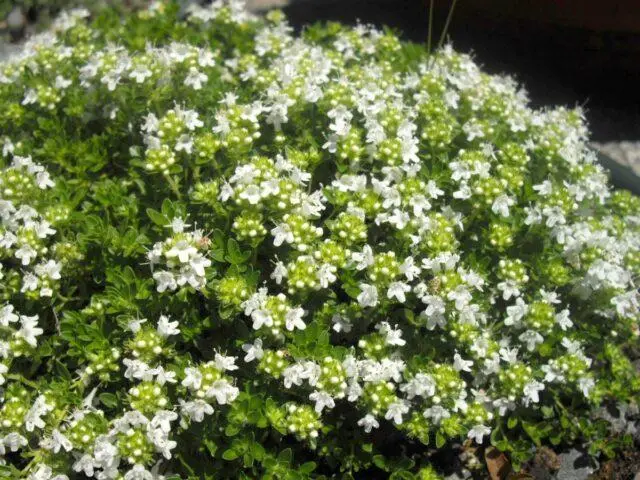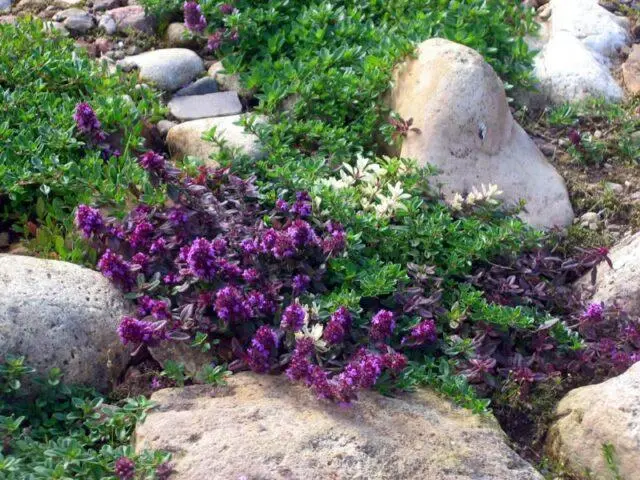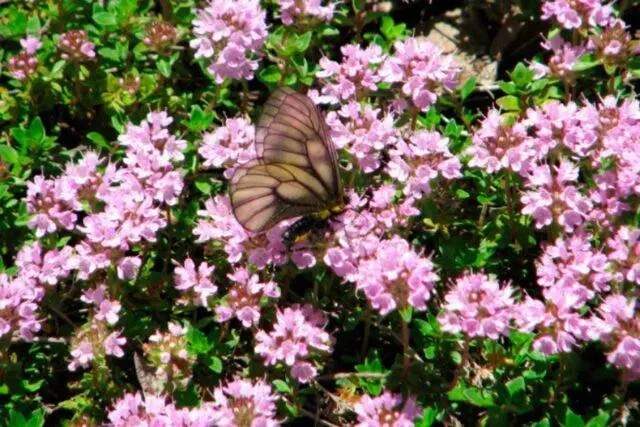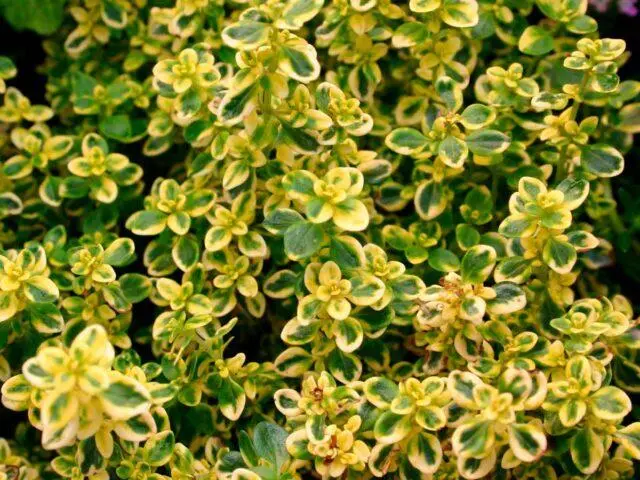Contents
- What does creeping thyme look like
- Where does creeping thyme grow and when does it bloom?
- Types and varieties of creeping thyme
- Medicinal and beneficial properties of creeping thyme
- The use of creeping thyme in medicine
- Harm and contraindications
- When to plant creeping thyme
- Planting thyme creeping seeds
- Creeping thyme care
- How to propagate creeping thyme
- Photo of creeping thyme in landscape design
- Conclusion
Thyme, or creeping thyme (Thymus serpillum), is a perennial semi-shrub plant that forms low turfs. This spicy-aromatic culture belongs to the Lamiaceae family. The popular names for thyme are Bogorodskaya grass, fly, pineapple. The perennial is widely used in landscape design, as it retains its decorative effect throughout the entire warm period. The plant is also valued for its medicinal properties. Growing thyme does not cause any particular difficulties, given the basic requirements of the culture.

Creeping thyme is considered one of the best honey plants.
What does creeping thyme look like
Thyme is a lodging semi-shrub, the height of which does not exceed 15-20 cm, and the growth diameter is 60 cm. Its creeping-type shoots are densely intertwined and quickly take root when in contact with the soil. Therefore, thyme plantings form a dense carpet on the surface of the soil. Growing shoots of creeping thyme are thin, flexible, green. As they mature, they become woody at the base.
The leaves of the perennial are small, oval-oblong, hard, dark or light green in color with short petioles. The plates are oppositely located on the shoots.
The flowers are small, two-lipped, pink-purple. They are collected in capitate inflorescences. The fruits of thyme are in the form of a small elliptical nut with a diameter of 0,6 cm. They ripen in early July.

Thyme is a close relative of basil, lavender, oregano, rosemary, mint, lemon balm
Where does creeping thyme grow and when does it bloom?
Creeping thyme can be found in temperate climates. A perennial semi-shrub grows mainly in the steppe zones. In the forest, it is found only in open sunny areas. Can grow on rocks, rocky slopes. Thyme begins to bloom in the first decade of June and continues until mid-September.
Creeping thyme is distributed from Scandinavia to the Mediterranean and from the British Isles to Eastern Siberia.
Types and varieties of creeping thyme
Breeding work made it possible, on the basis of the wild-growing form of thyme, to obtain new ornamental plant species with different colors of flowers. This increased the popularity of creeping thyme as a landscape design element.
Popular varieties:
- Albus (Albus). An early variety of culture that blooms at the end of May. The height of the plant does not exceed 8 cm. A characteristic difference is the spherical apical inflorescences of a white hue. The leaves are dark green with a bluish bloom and a delicate aroma.

Variety Albus is characterized by lush flowering
- Atropurpurea (Atropurpurea). The height of the plant reaches 20 cm. The growth diameter is 65-70 cm. The flowers of this variety are dark purple in color, and the leaves are green. Begins to form buds in early June.

Atropurpurea variety can be planted in sunny and lightly shaded areas.
- Bressingham Pink. Plant height reaches 15 cm, and growth diameter is 60 cm. Spherical inflorescences are pink. The leaves are small, green. Blooms in the first half of June.

Variety Brezingam Pink unpretentious to growing conditions
- Variegatus (Variegatus). A characteristic difference of this variety is a wide light border on the leaves. The height of the plant reaches 15 cm, and the diameter of the growth is about 65 cm. The shade of the petals is lilac.

Variety Variegatus is more demanding to care
Medicinal and beneficial properties of creeping thyme
For medicinal purposes, the aerial part of thyme is used, which is characterized by a rich chemical composition. The collection of medicinal raw materials must be carried out in July, since during this period the concentration of useful components is maximum.
Leaves and shoots of thyme contain:
- essential oil;
- saponins;
- flavonoids;
- resin:
- mineral salts;
- tannins;
- bitterness;
- acids (quinic, oleanolic, coffee, ursolic, chlorogenic, thymic).
Creeping thyme has long been used in Our Country for medicinal purposes. It was believed that this divine herb is able to return not only health, but also life to a person.
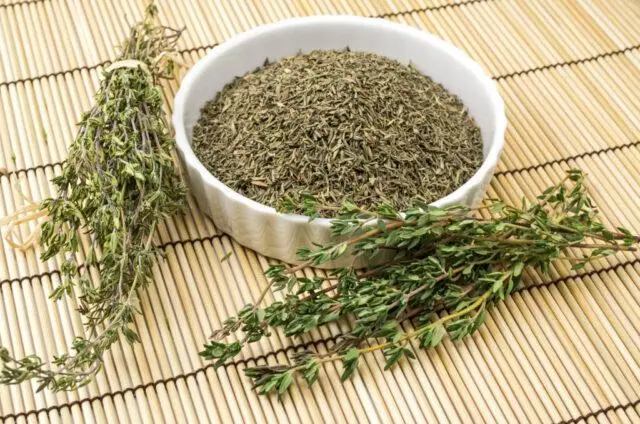
Thyme, powdered, given to sniff in fainting
Thyme has a number of useful properties, among which;
- expectorant;
- antimicrobial;
- warming;
- pain reliever;
- antipyretic;
- diuretic;
- soothing.
It has also been found that creeping thyme normalizes the function of the genital organs.
The use of creeping thyme in medicine
Thyme is also widely used in traditional medicine. An aqueous infusion is prescribed for rinsing the mouth with bronchial asthma, tracheitis, sinusitis, toothache, tonsillitis, bronchopneumonia.
Preparations with creeping thyme are used to treat neurosis, gastrointestinal diseases, insomnia, prostate adenoma. The drug Pertussin containing thyme extract is recommended for tuberculosis, whooping cough, bronchitis.
Harm and contraindications
Despite the benefits of creeping thyme, in some cases it can be harmful to health. Do not use it to treat children under two years of age. Long-term use of drugs based on it can lead to the development of Graves’ disease caused by hyperfunction of the thyroid gland.
Contraindications:
- pregnancy;
- renal, heart failure;
- the period of exacerbation of the ulcer.
When to plant creeping thyme
To grow creeping thyme in your backyard, you need to properly plant. This should be done in the spring, when the soil warms up to a temperature of at least +13 ° C. Therefore, the best time is the second half of May.
Planting thyme creeping seeds
For planting thyme, it is recommended to choose an open, well-lit place, protected from cold gusts of wind. Maximum decorativeness can be achieved when growing creeping thyme on sandy loamy soil with a neutral or low acidity level.
The site needs to be dug up in the fall and humus added at the rate of 10 kg per 1 sq. m, and add superphosphate (30 g) and potassium sulfide (25 g) to the same area. And with the arrival of spring heat, loosen the soil and carefully level the surface.
Landing algorithm:
- Make furrows 1 cm deep at a distance of 25 cm.
- Moisten the soil well.
- Spread the seeds evenly into the furrows.
- Sprinkle with a thin layer of river sand.
At the end of planting, the bed should be covered with agrofiber. When sprouts appear, they need to be thinned out, leaving only the strongest ones. Shelter can be removed when the seedlings are well established.
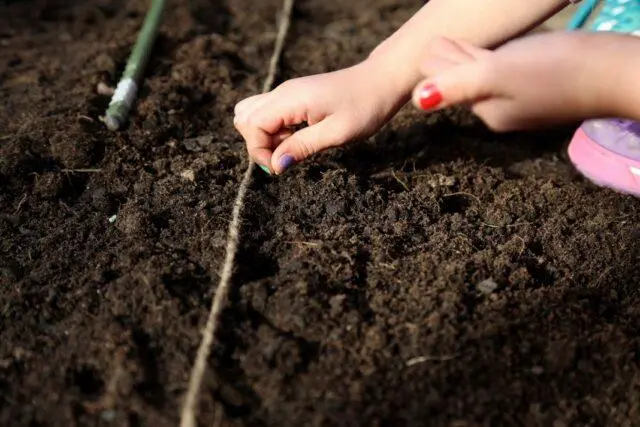
Creeping thyme seeds germinate 2-3 weeks after planting
Creeping thyme care
Thyme belongs to the category of unpretentious crops. But at the same time, it does not tolerate stagnant moisture in the soil. Therefore, creeping thyme should be watered only with a long absence of rain. To do this, use settled water with a temperature of +20 ° C. Young shoots need to be moistened more than twice a week, and adult plants – once every seven days.
Throughout the growing season, weeding should be carried out, removing growing weeds. It is also necessary to loosen the soil at the base of the plants in order to maintain air access to the roots. In hot periods, you need to lay mulch between creeping thyme seedlings. To do this, you can use peat or humus.
In the first year after planting, creeping thyme does not need to be fed. It is necessary to start fertilizing from the second season. To do this, organic matter should be used in early spring, and phosphorus-potassium mineral mixtures should be used at the beginning of summer and after flowering.
Sanitary pruning is a prerequisite for the proper care of creeping thyme. You need to do it twice per season. It is important to clean up perennials for the first time in the spring, removing all broken, dry and damaged shoots. This stimulates the growth of young shoots.
The second time pruning should be done after flowering. During this period, it is necessary to shorten the creeping thyme shoots by 2/3 of the length. This helps to make the semi-shrub lush and profusely flowering.
How to propagate creeping thyme
To obtain new thyme seedlings of the variety you like, experienced flower growers recommend dividing the bush or using cuttings.
In the first case, in early spring, you need to dig up a perennial and divide it into parts. Each of them should have well-developed root processes. After the procedure, the delenki must be immediately planted on the prepared site, watered abundantly and covered with agrofiber to speed up adaptation.
In the second case, cuttings of creeping thyme are necessary at the beginning of summer before flowering. For this, apical shoots 8-10 cm long should be used. Cuttings should be planted in a moist soil mixture. When planting, the lower part of the shoot 2 cm long should be cleaned of leaves, and then powdered with any root former. After the procedure, cover the seedlings with a transparent bag to create favorable conditions for rooting. Periodically plantings need to be ventilated and moistened with a spray bottle.
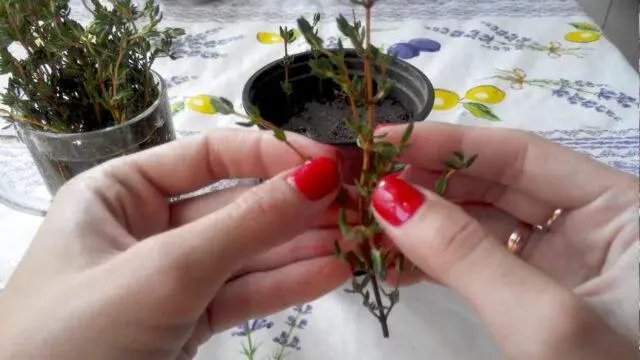
Creeping thyme cuttings take root in 20-25 days
Photo of creeping thyme in landscape design
The high decorative qualities of creeping thyme were able to be appreciated by landscape designers. Its undersized turfs help create bright accents and successfully mask unsightly areas. And the increased viability of the plant allows it to be grown even in places where other crops usually die.
You can clearly see how elegant creeping thyme looks in a flower bed and not only in the photo.

Suitable thyme creeping for framing paths
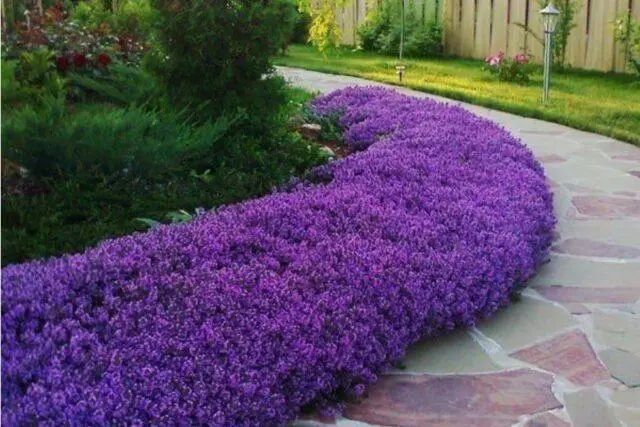
In group plantings, creeping thyme is best planted in the foreground.
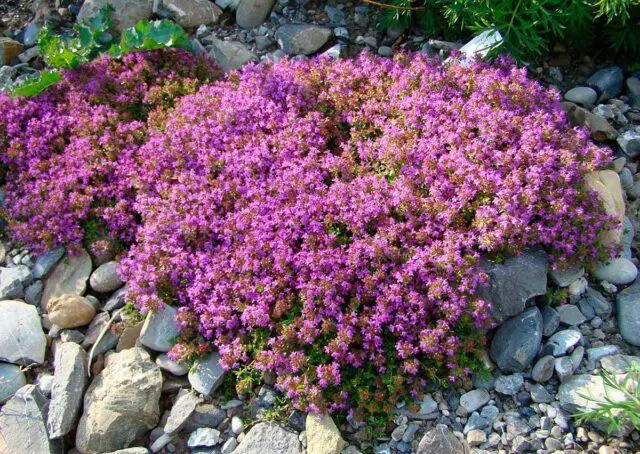
Perennial looks perfect on rocky hills
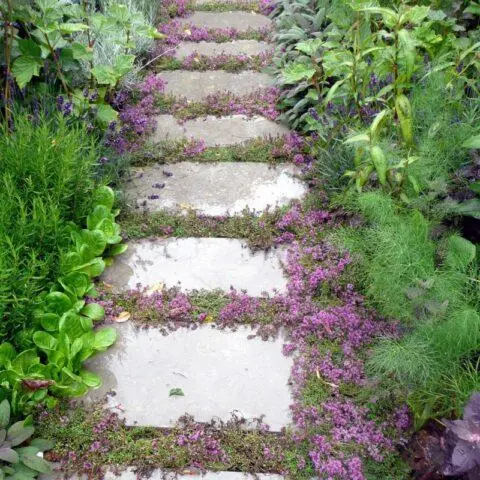
Perennial can be a good decoration for the borders of the paths

Semi-shrub can be used to strengthen slopes
Conclusion
Creeping thyme is a low-growing perennial that is widely used in medicine and cooking, as it has healing properties and a pleasant aroma. But also the cultivation of thyme in the backyard makes it possible to obtain a highly ornamental plant that can easily fit into any garden design. At the same time, the perennial does not require complex care, and is also able to grow and fully bloom on depleted soil.










